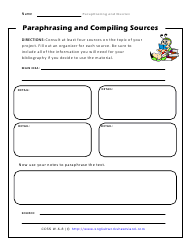Paraphrasing and Quotes Worksheets
Related ELA Standard: W.6.8

As we grow as a reader and writer, we will often be required to take the words of others and present them in our own words. This can be used to present evidence or the work of others. This process is called paraphrasing. This is a flagship academic skill. Some people can do it so well that they can take someone else’s words and throw language gasoline on them to make them better than we ever thought. Some writers are not as imaginative, and they use the words of others directly. This is called a quote and is often accompanied with quotation marks. These worksheets will help students learn to paraphrase and use quotes in their own work.
Paraphrasing and Quotes Worksheets To Print:
Paraphrasing – We first
ask you to identify where you need to draw your focus.
Paraphrasing
Information – Highlight what you think is most important. Then
paraphrase the highlighted information below.
Do You Buy It?
– Pretend you are writing a report about what it is like to live
with cancer.
On Military Might
– The text below is from John F. Kennedy's inaugural address given
on 20 January, 1961.
Research Refresher
– All children are influenced by their parents; but sometimes the
influence of one parent has more impact than that of another.
Quote Them Up
– What evidence does the author offer that support your thesis?
Write down what you would like to quote from the document.
Vivid Memories
– Imagine that the text below is a transcribed recording of an interview
that you conducted exactly one month ago with a 100-year-old woman
name Eunice Moreland.
Say It Better!
– When you paraphrase, you write the ideas from the text in your
own words.
What Is Paraphrasing?
Paraphrasing is the process of restating a text. It uses a different tone and format but the information and the main points are the same. Here are some ways through which you can easily paraphrase any text.
Read
If you want to paraphrase a written piece, the first step would be to read it a few times. Reading the passage is important because it will make you understand the main theme of the text. Reading it a few times before paraphrasing will make the process much easier for you. You can also think of different ways of paraphrasing the text while reading it.
Summarize
The next step is to decide whether you want all of the information or just the main points from the text. For this, you must know the purpose of paraphrasing. It will help you with making the decision.
Think Of Your Tone
Once you are done with the steps above, you can start developing ideas for your own style and tone of writing. You can think of ways through which you can present that text in your style.
Write In Your Words
For the first draft of paraphrasing, you can start writing in your own words. Try to stay away from the format of the original text. You don't want your paraphrasing to look like it was copied. It should be completely different from the original text. Think of how you will explain it to a friend and then write in those words.
Use Synonyms
To avoid the usage of the same language, you can shift to synonyms. You can use as many synonyms as possible. This will make your text look unique and new.
Use A Different Sentence Structure
Do not follow the same sentence structure as of the original text. Use different ways of writing. Start your sentence with a different point of view to make it look new.
Break the Information Into Smaller Sentences
If the original text has long and complex sentences, you can break that information down into smaller sentences. This will help you in paraphrasing the text in a way that won't look copied. It will also be much easier to understand.

